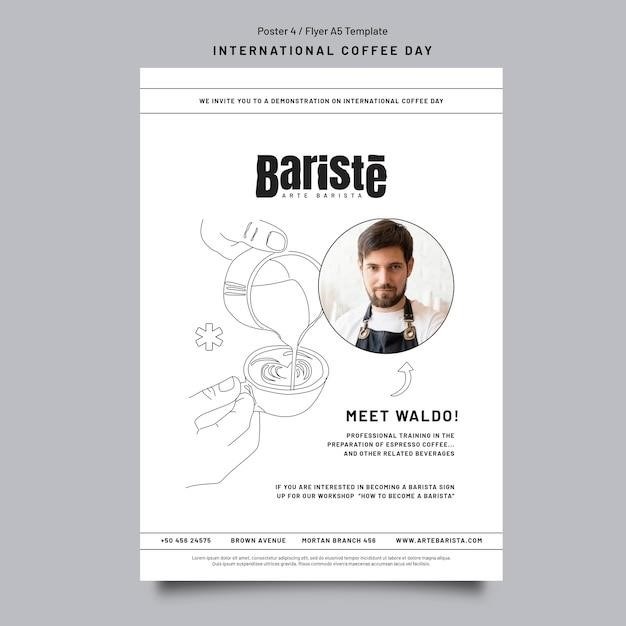farberware air fryer instruction book
Farberware Air Fryer Instruction Book⁚ A Comprehensive Guide
This comprehensive guide provides detailed instructions and helpful tips for using your Farberware Air Fryer. From understanding the components and control panel to exploring basic cooking techniques and troubleshooting common issues, this guide will empower you to enjoy delicious, healthy meals cooked to perfection.
Introduction
Welcome to the world of healthy and delicious cooking with your Farberware Air Fryer! This innovative appliance allows you to enjoy crispy, flavorful meals with minimal oil, making it a healthier alternative to traditional frying. This instruction manual will guide you through every step of using your Farberware Air Fryer, from unpacking and setup to mastering basic cooking techniques and exploring a world of delicious recipes. Whether you’re a seasoned cook or a culinary novice, this guide will provide the information you need to unlock the full potential of your Farberware Air Fryer and create mouthwatering dishes that will impress your family and friends.
Safety Precautions
Your safety is our top priority. Please read and understand the following safety precautions before using your Farberware Air Fryer. Always unplug the appliance from the power outlet when not in use, before cleaning, or when assembling or disassembling parts. Never operate the Air Fryer with a damaged cord or plug. Do not immerse the Air Fryer, cord, or plug in water or any other liquid. Never leave the Air Fryer unattended while in operation. Always place the Air Fryer on a flat, stable surface away from heat sources and flammable materials. Exercise caution when handling hot surfaces, using oven mitts or potholders to avoid burns. Do not use the Air Fryer for any purpose other than its intended use.
Understanding Your Farberware Air Fryer
Your Farberware Air Fryer is designed for convenient and healthy cooking. Familiarize yourself with its components and functions to make the most of your culinary experience; The Air Fryer typically includes a main unit, a removable basket, a non-stick pan, and a control panel. The control panel features a temperature dial, a timer knob, and potentially other functions depending on your model. The temperature dial allows you to adjust the cooking temperature, while the timer knob sets the duration of the cooking process. Understanding these components and functions will empower you to cook a wide variety of dishes with ease and precision.
Components and Accessories
Your Farberware Air Fryer comes equipped with essential components and accessories to facilitate your cooking endeavors. The main unit houses the heating element and fan system, responsible for circulating hot air and creating a crispy texture. The removable basket is designed to hold your food during cooking, allowing for easy access and cleaning. The non-stick pan sits beneath the basket, catching any drippings and ensuring easy cleanup. Additionally, some models may include a glass tray, a turntable ring, and a turntable hub. These accessories enhance the functionality of your Air Fryer, allowing you to cook a wider variety of dishes and achieve consistent results.
Control Panel and Functions
The control panel of your Farberware Air Fryer serves as your command center for precise cooking. It typically features a timer knob, a temperature dial, and various function buttons. The timer knob allows you to set the cooking duration, ranging from a few minutes to several hours. The temperature dial lets you adjust the heat level, typically from 100 to 450 degrees Fahrenheit, allowing you to achieve the perfect degree of doneness for different foods. The function buttons may include settings for air frying, baking, roasting, grilling, and reheating. Understanding these functions and their respective settings empowers you to create a diverse range of delicious meals in your Farberware Air Fryer.
Getting Started with Your Farberware Air Fryer
Before embarking on your culinary journey with your Farberware Air Fryer, ensure a smooth and safe experience by following these simple steps. Firstly, choose a stable and level surface for your Air Fryer, ensuring ample space around it for ventilation. Unpack the appliance carefully, examining all components for any damage or missing parts. Next, familiarize yourself with the user manual, paying close attention to safety precautions and operating instructions. Finally, plug the Air Fryer into a dedicated electrical outlet, ensuring it is properly grounded. Now you are ready to begin exploring the world of air-fried delights!
Placement and Setup
The placement of your Farberware Air Fryer is crucial for safety and optimal performance. Select a flat, stable surface, ensuring ample space around the appliance for ventilation. Avoid placing it near flammable materials or heat sources. Before plugging it in, ensure the power cord is not damaged or frayed. Upon unpacking, inspect the components and accessories. The user manual provides detailed guidance on assembling and installing accessories, such as the basket and pan. Finally, ensure the air fryer is properly grounded to prevent electrical hazards. These simple steps will guarantee a safe and enjoyable cooking experience with your Farberware Air Fryer.
Preheating
Preheating your Farberware Air Fryer is essential for achieving crispy, evenly cooked results. To preheat, simply set the desired temperature using the control panel and turn the timer knob for more than three minutes. The red light will indicate that the air fryer is preheating, and will turn off when it has reached the set temperature. You can also preheat the air fryer without any ingredients in the basket. Once the red light turns off, you can place your food in the basket and set the cooking time. Preheating ensures that the air inside the fryer is hot enough to quickly cook your food, resulting in a crispy exterior and a tender interior. For optimal results, always preheat the air fryer according to the instructions in your user manual.
Cooking with Your Farberware Air Fryer
Your Farberware Air Fryer opens up a world of culinary possibilities, allowing you to create delicious and healthy meals with ease. The air fryer’s rapid air circulation technology ensures crispy, golden-brown results without the need for excessive oil. From appetizers to main courses and even desserts, the air fryer can handle a wide variety of dishes. Experiment with different cooking times and temperatures to achieve your desired level of doneness. Always refer to your user manual for specific cooking instructions and guidelines. Enjoy the convenience, versatility, and deliciousness that your Farberware Air Fryer brings to your kitchen!

Basic Cooking Techniques
Mastering the art of air frying is surprisingly simple. Start by preheating your Farberware Air Fryer to the desired temperature, as this ensures even cooking and optimal results. Place your ingredients in the basket, making sure they are not overcrowded to allow for proper air circulation. Set the timer according to the recipe or your preferred cooking time. Keep an eye on your food as it cooks, checking for doneness and adjusting the time as needed. For best results, shake or stir the food halfway through the cooking process to ensure even browning. Once cooked, carefully remove the basket from the air fryer and enjoy your crispy, flavorful creations.
Recipes and Inspiration
The Farberware Air Fryer opens up a world of culinary possibilities, allowing you to create delicious and healthy meals with ease. Explore a wide array of recipes, from crispy fries and juicy chicken wings to flavorful vegetables and even baked goods. Get creative with your ingredients and experiment with different seasonings and marinades to discover your favorite flavor combinations. Online resources offer a wealth of air fryer recipes, catering to various dietary needs and preferences. Whether you’re looking for quick weeknight meals or impressive party appetizers, your Farberware Air Fryer will become your go-to appliance for culinary inspiration.
Cleaning and Maintenance
Proper cleaning and maintenance are crucial for ensuring the longevity and optimal performance of your Farberware Air Fryer. After each use, allow the appliance to cool completely before cleaning. Unplug the air fryer and remove the basket and pan. Wash the basket and pan with warm, soapy water, using a non-abrasive sponge or brush. Avoid using harsh chemicals or scouring pads that can damage the non-stick coating. The air fryer’s exterior can be wiped clean with a damp cloth. Regularly inspect the heating element and remove any food debris to prevent build-up. For deep cleaning, consult the user manual for specific instructions. Proper cleaning and maintenance will ensure your Farberware Air Fryer remains in top condition, allowing you to enjoy delicious and healthy meals for years to come.
Troubleshooting
While your Farberware Air Fryer is designed for reliable performance, occasional issues may arise. If your air fryer is not heating properly, ensure it is plugged in securely and the power switch is turned on. Check if the heating element is clean and free of debris. If the timer is not functioning correctly, try resetting the air fryer by unplugging it for a few minutes and then plugging it back in. If the air fryer is making unusual noises, inspect the basket and pan to ensure they are properly seated and not rattling. In case of any persistent issues, refer to the user manual for more detailed troubleshooting tips or contact Farberware customer support for assistance. By addressing these common problems promptly, you can maintain the optimal functionality of your air fryer and continue to enjoy delicious, healthy meals.
Frequently Asked Questions
Here are some frequently asked questions about Farberware Air Fryers⁚
- What are the settings for the Farberware French Door air fryer? The Farberware French Door air fryer typically has settings for temperature, time, and cooking function. You can adjust the temperature from 100 to 450 degrees Fahrenheit and set the timer for up to 24 hours. The cooking functions may include air frying, baking, roasting, and reheating.
- Does a Farberware air fryer need to preheat? While preheating is not always necessary, it can help achieve optimal cooking results. Preheating your Farberware air fryer for a few minutes before adding food can ensure even cooking and a crispier texture.
- How do you use an air fryer step by step? 1. Place the air fryer on a solid, flat surface. 2. Remove the pan and basket from the air fryer. 3. Pre-heat the air fryer for 3 minutes by turning on the timer knob and waiting for the red light to turn off. 4. Place the food in the basket and set the desired cooking time. 5. Once the timer goes off, carefully remove the basket from the air fryer.
If you have any other questions, consult your Farberware air fryer instruction manual or visit the Farberware website for more information.










